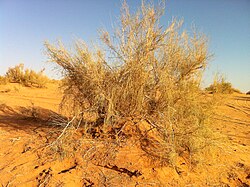| Haloxylon persicum | |
|---|---|
 | |
| Haloxylon persicum in Unaizah | |
| Scientific classification | |
| Kingdom: | Plantae |
| Clade: | Tracheophytes |
| Clade: | Angiosperms |
| Clade: | Eudicots |
| Order: | Caryophyllales |
| Family: | Amaranthaceae |
| Genus: | Haloxylon |
| Species: | H. persicum |
| Binomial name | |
| Haloxylon persicum | |
Haloxylon persicum, the white saxaul, is a small tree belonging to the family Amaranthaceae. [2] [3] Its range is Western Asia, including the Palestine region, Egypt, Sinai, Israel, South Iraq, Saudi Arabia, Iran, Oman, UAE, Afghanistan, Pakistan, Central Asia (Kyrgyzstan, Turkmenistan, etc.), and China (Xinjiang etc.).
